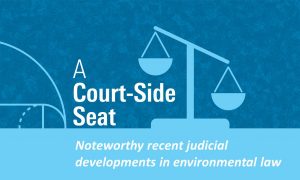The courts have issued several new and significant rulings on environmental and administrative law the past few weeks.
U.S. COURT OF APPEALS FOR THE DISTRICT OF COLUMBIA CIRCUIT
Truck Trailer Manufacturers Association, Inc. v. EPA
On November 12, 2021, the DC Circuit held in a divided ruling that neither Section 202(a)(1) of the Clean Air Act nor the Energy Independence and Security Act of 2017 authorized these agencies to regulate the greenhouse gas emissions released by trailers pulled by tractors—most commonly, the 18 wheelers that carry many products to market on the nation’s highways. According to the court, trailers have no motor, and therefore cannot be subject to the Greenhouse emissions and fuel efficiency standards promulgated in 2016. (See 81 FR 73478.) The majority, after an exacting review of these statutes, determined that the Clean Air Act did not authorize that portion of EPA’s rule insofar as it applies to heavy-duty trailers, and since the Energy Independence Act concentrates on fuel economy, and trailers use no fuel, there was also no authority for the NHTSA to employ. Judge Millett agreed with the majority regarding the EPA rules but would hold that the NHTSA’s inclusion of commercial trailers in its fuel efficiency rule was a reasonable interpretive judgment that “falls squarely within its statutory delegation.”
U.S. COURT OF APPEALS FOR THE FIFTH CIRCUIT
BST Holdings, et al. v. OSHA
On November 12, 2021, the court reiterated its recent ruling that the new OSHA Emergency Temporary Standard COVID-19 affecting employers of 100 or more employees must be stayed pending judicial review. Following its review and consideration of the new briefing it received, the court again outlined what it believed to be “grave statutory and constitutional issues” with the new OSHA mandate, which has been published at 86 FR 61402. A stay will do OSHA “no harm whatsoever” the court concludes, while the companies seeking a stay “will be irreparably harmed.” In a footnote, the court observes that “the Mandate affects every person in America one way or another.” Ordinarily, a trial on the merits would soon follow.
U.S. COURT OF APPEALS FOR THE NINTH CIRCUIT
Inland Waterkeeper v. Corona Clay Company
On September 20, 2021, the court ruled that the environmental plaintiffs had standing to pursue this Clean Water Act Citizen Suit action, which alleged that the defendant was illegally discharging pollutants into a body of navigable water in violation of its California state Stormwater General Discharge permit. The basis of this complaint was the alleged failure of the defendant to monitor its stormwater discharges and to report its permit violations. The case was tried by a jury, which ruled for the defendant on some issues, in particular whether there was in fact a jurisdictional discharge to navigable waters. The Ninth Circuit held that the lower court erred when it ruled that, in its interpretation of the Supreme Court’s decision in Gwaltney v. U.S., an ongoing discharge was a prerequisite for maintaining a citizen suit asserting ongoing monitoring and reporting violations. Still, whether there was in fact a jurisdictional discharge in light of the Supreme Court’s holding in the 2020 County of Maui case is an issue to be decided by the trial court on remand.
California River Watch v. City of Vacaville
On September 27, 2021, the Ninth Circuit issued a ruling in this RCRA suit, with the plaintiffs arguing that the City of Vacaville, in transporting a dangerous solid waste, hexavalent chromium, to its residents as part of its municipal water service, was nevertheless in violation of Section 6972(a) of RCRA. Although the city had nothing to do with the actual generation of hexavalent chromium, a chemical used and released into groundwater by wood treatment facilities located in nearby Elmira, Calif., a “transporter” of solid waste can still face liability under RCRA. The court also held that discarded hexavalent chromium was a solid waste subject to RCRA; here, it is alleged that the wood treatment plants released this chemical into the groundwater, which was the basic source of the water provided the Vacaville residents, which triggered the application of RCRA. Oddly enough, EPA agreed the operation of the municipal water plant was otherwise in compliance with the applicable state and federal safe drinking water act standards. There was a dissent, with the dissenting judge stating that the City had to have taken an active role in creating this waste before it could be liable.
Upper Missouri Waterkeeper v. EPA
On October 6, 2021, the court ruled on this controversy, which concerned Montana’s new water quality standards which the State proposed and EPA approved. The plaintiffs argued that Montana, in promulgating water quality standards for nitrogen and phosphorus in “wadeable streams,” could not consider the costs of compliance. The trial court and the court of appeals agreed that the Clean Water Act and the implementing water quality regulations, do not foreclose the use of an economic test in some circumstances, and since the Clean Water Act’s text is not dispositive, then Chevron deference should be applied to a reasonable interpretation of the law. However, the trial court took issue with the conditions of 17-year variance provided by Montana, but the Ninth Circuit could find no authority for this ruling, and it was reversed.
RELATED ARTICLES
 Gravel2Gavel Construction & Real Estate Law Blog
Gravel2Gavel Construction & Real Estate Law Blog



